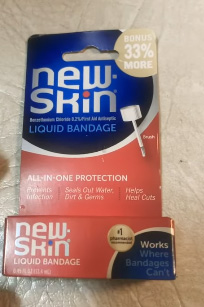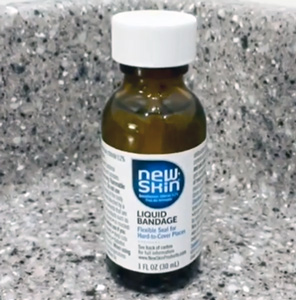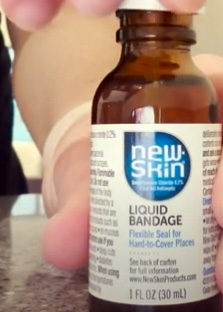When I first needed to close a small cut, I stood in the pharmacy aisle, staring at New Skin Liquid Bandage and wondering if it could match the hype of Dermabond, a surgical glue my doctor once used. Both promised quick, needle-free wound closure, but which one truly delivers? In this article, I’ll share my journey comparing New Skin and Dermabond, breaking down their pros, cons, and key features from a real-world perspective. Whether you’re treating a minor scrape or curious about surgical options, let’s find out which product suits your needs best.
Comparison Table: New Skin Vs. Dermabond
| Feature | New Skin Liquid Bandage | Dermabond Topical Skin Adhesive |
| Composition | Nitrocellulose, ethyl alcohol, butyl acetate | 2-Octyl cyanoacrylate |
| Primary Use | Minor cuts, scrapes, blisters | Surgical incisions, lacerations |
| Application Setting | Over-the-counter, home use | Medical settings, professional application |
| Strength | Moderate bond for small wounds | Strong bond for surgical and larger wounds |
| Flexibility | Highly flexible, ideal for joints | Less flexible, better for stable areas |
| Drying Time | 30–60 seconds | 30–60 seconds |
| Water Resistance | Waterproof once dry | Waterproof, forms bacterial barrier |
| Removal | Wears off naturally or with acetone | Sloughs off naturally, no manual removal needed |
| Cost | $5–$10 per bottle | $20–$50 per vial (professional use) |
| Availability | Widely available at pharmacies | Prescription or hospital use only |
| Pain on Application | Stinging due to alcohol content | Minimal pain, medical-grade formula |
| Cosmetic Outcome | Good for small wounds, may leave residue | Excellent, minimal scarring for surgical wounds |
My Journey With Wound Closure
Also Read: My Thought on ZO Skin Health Exfoliating Polish Review

A few years ago, I sliced my finger while chopping vegetables. It wasn’t deep enough for stitches, but it wasn’t just a paper cut either. Panicked, I grabbed New Skin from my medicine cabinet, hoping it would save me a trip to the ER. The sting was intense, but the cut sealed quickly, and I was back to cooking in minutes. Fast-forward to last year, when I had minor surgery, and the doctor used Dermabond to close the incision. The process was seamless, painless, and left barely a scar. These experiences sparked my curiosity: how do these two products stack up for everyday folks like you and me?
New Skin and Dermabond both aim to close wounds without needles, but they serve different purposes. New Skin is the go-to for minor mishaps at home, while Dermabond is a medical-grade marvel used in operating rooms. To understand which one fits your needs, I’ve explored their features, tested their claims, and weighed their strengths and weaknesses. Let’s break it down.
Understanding New Skin Liquid Bandage
New Skin Liquid Bandage is like the Swiss Army knife of first aid. It’s a topical solution you can buy at any drugstore, designed for minor cuts, scrapes, and blisters. The active ingredient, nitrocellulose, forms a flexible film over the wound, acting like an artificial skin that protects while it heals. I remember using it on a blister from new hiking boots—it stung like crazy at first, but once it dried, it kept dirt out and let me keep trekking.
Key Features of New Skin
- Accessibility: You can grab New Skin off the shelf for about $5–$10. No prescription needed, making it perfect for home use.
- Flexibility: The film it forms moves with your skin, which is great for areas like knuckles or elbows that bend a lot.
- Waterproof: Once dry, it’s a solid barrier against water, so you can shower or wash dishes without worry.
- Ease of Use: The brush applicator is straightforward, though it can feel a bit like painting your nails with a strong-smelling polish.
- Antiseptic Properties: Some versions include antiseptics to reduce infection risk, though it’s not as robust as medical-grade options.
Pros Of New Skin
- Affordable and Accessible: At under $10, it’s a budget-friendly option for minor injuries. You don’t need a doctor’s visit to get it.
- Quick Application: It dries in under a minute, so you’re not waiting around. I applied it to a scraped knee once and was back to chasing my dog in no time.
- Flexible for Active Lifestyles: Its elasticity makes it ideal for wounds in high-movement areas. I’ve used it on my fingers during gardening, and it held up through dirt and sweat.
- No Removal Needed: It peels off naturally as the wound heals, usually within a few days, sparing you the hassle of pulling out stitches.
- Versatile: Beyond cuts, it works for blisters, cracked skin, and even small burns, making it a staple in my first-aid kit.
Cons Of New Skin

- Stinging Sensation: The alcohol content burns on application, especially on open wounds. I winced when I used it on a fresh cut, and it’s not kid-friendly.
- Limited Strength: It’s not designed for deep or wide wounds. When I tried it on a slightly larger gash, it didn’t hold as well as I’d hoped.
- Odor and Residue: The chemical smell is strong, and sometimes it leaves a shiny residue that’s noticeable on visible areas like hands.
- Not for Contaminated Wounds: If your wound is dirty, New Skin won’t cut it. You need to clean thoroughly first, which can be tricky in a pinch.
- Potential Skin Irritation: Some folks, including me on one occasion, get mild redness from the alcohol or other ingredients, especially with repeated use.
Exploring Dermabond Topical Skin Adhesive
Also Read: My Thought on ZO Skin Health Exfoliating Polish Review
Dermabond, on the other hand, feels like something out of a sci-fi movie. It’s a medical-grade adhesive made of 2-octyl cyanoacrylate, designed to seal surgical incisions and larger lacerations. When my surgeon used it after a minor procedure, I was amazed at how quickly it set and how clean the scar looked months later. It’s not something you’d find in a pharmacy—it’s typically applied by professionals in sterile settings.
Key Features Of Dermabond
- Medical-Grade Strength: Dermabond forms a robust bond, capable of holding larger wounds together, often replacing sutures or staples.
- Bacterial Barrier: It creates an airtight, waterproof seal that blocks bacteria, reducing infection risk. Studies show it inhibits pathogens like MRSA and E. coli.
- Cosmetic Excellence: It’s known for minimal scarring, which is why it’s a favorite for facial surgeries or visible areas.
- Quick Application: Like New Skin, it dries in about 30–60 seconds, but it’s applied with precision using a specialized applicator.
- No Removal Required: It sloughs off naturally in 5–10 days, blending seamlessly with the healing process.
Pros Of Dermabond
- Superior Strength: Dermabond is a powerhouse for surgical wounds. My incision stayed secure even during light activity, and it gave me peace of mind.
- Minimal Pain: Unlike New Skin’s sting, Dermabond’s application is nearly pain-free, which is a relief in a medical setting.
- Infection Protection: Its antimicrobial properties are a game-changer. Knowing my wound was shielded from bacteria made recovery less stressful.
- Cosmetic Results: The scar from my surgery is barely visible, a testament to Dermabond’s ability to promote clean healing. Studies confirm it matches or beats sutures for cosmetic outcomes.
- Time-Saving: It cuts down on operating room time, as it’s faster than stitching. This also means fewer follow-up visits for suture removal.
Cons Of Dermabond
- Costly and Restricted Access: At $20–$50 per vial, it’s pricey, and you can’t just buy it at Walgreens. It’s typically reserved for medical professionals.
- Less Flexible: It’s not as pliable as New Skin, so it’s less ideal for joints or areas that stretch a lot. My surgeon warned me to avoid heavy movement.
- Risk of Allergic Reactions: Some people experience contact dermatitis from the cyanoacrylate. I was fine, but it’s a known issue.
- Not for Contaminated Wounds: Like New Skin, it requires a clean wound. It’s useless for dirty or infected cuts, which limits its versatility.
- Professional Application: You need a doctor or nurse to apply it, which means it’s not a DIY solution for home accidents.
Head-To-Head Comparison
Let’s put these two side by side and see how they measure up in real-world scenarios. I’ve broken it down into key factors that matter when you’re choosing a wound closure solution.
Ease of Use
New Skin wins for accessibility. I can apply it myself with the brush applicator, even if I’m clumsy under pressure. The process is simple: clean the wound, brush on the liquid, and wait a minute. Dermabond, however, requires a trained hand. Its applicator is designed for precision, but you’re not getting your hands on it without a medical professional. For home use, New Skin is the clear winner; in a hospital, Dermabond’s precision shines.
Pain and Comfort
New Skin’s sting is a dealbreaker for some. When I used it on a fresh cut, the alcohol burn made me grit my teeth. Dermabond, by contrast, was a breeze during my surgery—no pain, just a cool sensation as it dried. For kids or anyone sensitive to discomfort, Dermabond is the kinder choice, but you’ll need a doctor to apply it.
Strength and Durability

Dermabond takes the crown here. Its 2-octyl cyanoacrylate formula creates a bond strong enough for surgical incisions, even when paired with deep stitches. New Skin’s nitrocellulose is great for small cuts, but it struggled when I tried it on a deeper scrape. Studies show Dermabond’s tensile strength is superior, making it ideal for larger wounds.
Cosmetic Outcomes
Both products aim for minimal scarring, but Dermabond edges out. My surgical scar is nearly invisible, and research backs this up—Dermabond often outperforms sutures for cosmetic results, especially on the face. New Skin does well for minor wounds, but I’ve noticed it can leave a slight residue that makes the area look shiny for a while.
Cost and Accessibility
New Skin is the budget champ. At $5–$10, it’s a no-brainer for home use. Dermabond’s $20–$50 price tag, plus the need for professional application, makes it a luxury reserved for medical settings. However, studies suggest Dermabond can save money in the long run by reducing follow-up visits and complications.
Infection Prevention
Dermabond’s antimicrobial properties give it a leg up. It forms a seal that blocks bacteria like MRSA, which is critical in surgical settings. New Skin offers some antiseptic protection in certain formulations, but it’s not on the same level. For minor wounds, this might not matter, but for surgery, Dermabond’s barrier is a lifesaver.
Flexibility and Mobility
New Skin’s flexibility is a standout. I used it on a cut near my knuckle, and it stretched with every bend without cracking. Dermabond, while strong, is less pliable, which can be an issue for joints. If you’re active or treating a wound in a high-movement area, New Skin is more practical.
Removal and Aftercare
Both products slough off naturally, which is a huge plus. New Skin peels away in a few days, sometimes faster if you’re active. Dermabond takes 5–10 days, aligning with surgical healing timelines. However, New Skin’s alcohol content can irritate if you reapply too often, and Dermabond’s adhesive can loosen if exposed to certain chemicals. Neither requires a doctor’s visit for removal, unlike sutures or staples.
Real-World Scenarios: Which To Choose?

Let’s paint a few pictures to help you decide. Imagine you’re hiking and scrape your knee on a rock. It’s shallow but bleeding. New Skin is your go-to—clean the wound, brush it on, and keep moving. It’s cheap, easy, and flexible enough for your active day. Now picture a surgical incision after an appendectomy. Dermabond is the star here, offering a strong, infection-resistant seal that leaves a clean scar. For kids with small cuts, New Skin might be too painful, and Dermabond’s professional application isn’t practical for a quick fix. But for a facial laceration in the ER, Dermabond’s cosmetic benefits and pain-free application make it the better choice.
My Personal Take
Having used both, I lean toward New Skin for everyday mishaps. It’s affordable, accessible, and gets the job done for minor cuts and blisters. The sting is a downside, but I’ve learned to grit my teeth through it. Dermabond, though, is unmatched for serious wounds. My surgical experience showed me its strength and cosmetic benefits firsthand. If I had to choose for a home first-aid kit, New Skin wins for convenience. But if I’m in a hospital, I’d trust Dermabond to keep my wound secure and my scar minimal.
Frequently Asked Questions (Faq)
No, liquid skin (like New Skin) uses nitrocellulose and is for minor cuts, while Dermabond uses 2-octyl cyanoacrylate for surgical wounds. They’re similar but differ in strength and use.
Yes, New Skin acts like a glue by forming a protective film over minor wounds, sealing them to promote healing and prevent infection.
Alternatives include other cyanoacrylate glues like LiquiBand or Histoacryl, sutures, staples, or liquid bandages like New Skin for smaller wounds.
Dermabond is widely regarded as the best due to its strength, antimicrobial properties, and cosmetic outcomes, though LiquiBand and Histoacryl are competitive options.
Wrapping It Up
You’re standing at a crossroads with a cut that needs closing. Do you grab New Skin from the pharmacy shelf or ask your doctor for Dermabond? My journey showed me that New Skin is your trusty sidekick for minor scrapes and blisters—cheap, flexible, and easy to use at home, despite the sting. Dermabond, though, is the superhero for surgical wounds, offering unmatched strength, infection protection, and a scar you’ll barely notice. Use the comparison table to weigh your options, and choose based on your wound’s size, location, and setting. Whatever you pick, both products make needles and stitches feel like relics of the past.
CONCLUSION
Also Read: My Thought on ZO Skin Health Exfoliating Polish Review
As I reflect on my experiences with New Skin and Dermabond, I’m struck by how these products transform wound care, sparing you the dread of needles. New Skin’s affordability and flexibility make it my go-to for life’s little mishaps—scrapes from gardening or blisters from new shoes. Dermabond, with its surgical-grade strength and flawless cosmetic results, is a game-changer for serious wounds, as I learned post-surgery. Your choice depends on the wound’s severity and setting. Grab New Skin for quick home fixes, or trust Dermabond for professional care. Either way, you’re equipped to heal confidently and move forward.
